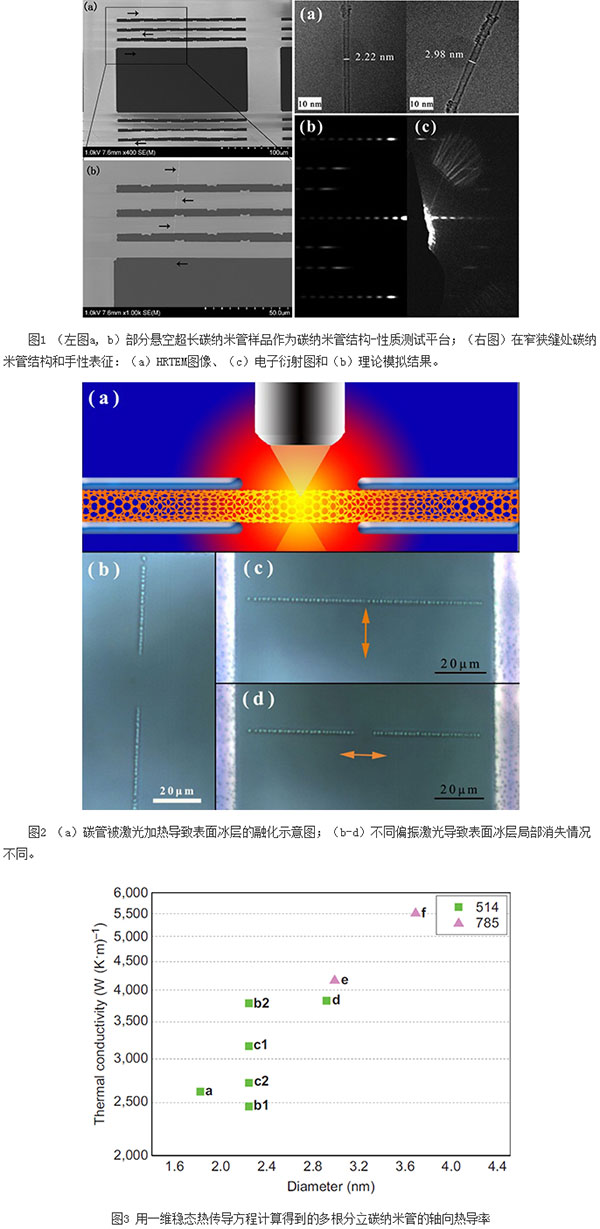
In order to study the properties and device performance of single carbon nanotubes, and to manipulate carbon nanotubes to obtain a specific structure, one often needs to locate a certain carbon nanotube under an optical microscope in order to perform spectral characterization and device construction. The traditional method of marking and positioning using a scanning electron microscope is tedious and easily contaminates carbon nanotubes. The optical visibility of nanomaterials can meet people's needs. However, the existing method of depositing metal or oxide nanoparticles on the surface of carbon nanotubes, while achieving visibility under an optical microscope, may lead to deterioration of the performance of the carbon nanotubes, which is not conducive to the exploration of the intrinsic properties of the carbon nanotubes.
The excellent properties of carbon nanotubes are easily influenced by the surrounding environment. In the past, the use of mixed samples to study the physical properties of carbon nanotubes can often only obtain the average information of various structures in the sample, and it is impossible to analyze the structure and physical properties of carbon nanotubes. Relationship. Therefore, characterization of the intrinsic physical properties of single carbon nanotubes has always been the forefront of research. For example, in the light absorption detection of carbon nanotubes, with the development of CCD technology and the increase of laser intensity, detecting a tiny optical signal is no longer a difficult problem. However, while detecting and amplifying the optical signal of a single carbon nanotube sample, it is still difficult to eliminate the effects of the substrate and the surrounding environment. In terms of the thermal properties of carbon nanotubes, theoretical studies have demonstrated that carbon nanotubes have extremely high thermal conductivity. However, due to the different measurement methods, the quality of the samples used was uneven and the structure was different. Carbon was experimentally measured. The thermal conductivity of nanotubes varies greatly. In addition to the structural characterization of carbon nanotubes, the use of non-contact methods to measure the temperature of nanomaterials is also a problem that must be addressed.
Institute of Physics, Chinese Academy of Sciences/Beijing National Laboratory for Condensed Matter Physics (CMM) Advanced Materials and Structure Analysis Laboratory “Nanomaterials and Mesoscopic Physics†Research Group (Group A05), has been dedicated to the preparation and physical properties of carbon nanotubes for many years And applied research. On the basis of previous work, Dr. Zhang Wei and others of the Chinese Academy of Sciences Academician Shi Sishen directed the development of a reversible, long-lasting and non-destructive method for optical visibility and intrinsic physical property detection of single-walled single-walled carbon nanotubes. (Chinese invention patent, application number 201410682661.7, 201410681975.5), recently, with Professor Song Li of the University of Science and Technology of China, Bai Xuedong, researcher of the SF1 group of the Institute of Physics, Dr. Tian Xuezeng, and Dr. Qi Xiaoying, doctor of the National Nanoscience Center, in a single hanging single wall The development of optically visible carbon nanotubes and their optical and thermal properties have made great progress.
Based on the partially suspended ultra-long carbon nanotubes, the nano-diameter carbon nanotubes are visible under an optical microscope by forming an ice-carbon nanotube micro-diameter-diameter heterogeneous shell core structure. By using different polarized lasers to illuminate the heterogeneous shell core structure, the light absorption cross-section problem of single carbon nanotubes is systematically studied based on the disappearance of different surface ice layers and the chirality of the carbon nanotubes determined by electron diffraction. Based on this laser-induced partial melting phenomenon, a piecewise one-dimensional steady-state heat conduction equation was established by using the temperature of the edge position of the laser spot determined by the red shift of the Raman G mode of the carbon nanotubes, and the constant ice boundary. The melting temperature is used as the boundary condition, combined with the geometric information of the carbon nanotubes, the axial thermal conductivity of the ultra-long carbon nanotubes with different chiralities calculated is in the range of 2000-6000 W K-1 m-1, which is close to the theoretical calculation. value. The relevant research results were published in (NPG) Light: Science & Applications (2015, 4, e318; DOI: 10.1038/lsa.2015.91).
The work was supported by projects of the Ministry of Science and Technology, the National Natural Science Foundation of China and the Chinese Academy of Sciences.
Our tricot safety vests are durable, lightweight and perfect for every day use. The velcro strips ensure strong, easy fastening and there is a large area available for badging/printing to the front and rear. Our safety vest are available up to size 7XL. vest with reflective tapes, fabric is 100% polyester, tricot fabric. This Tricot safety vest has large area for printing/Badging on front and rear.

Tricot safety vest, safety vest, vest, 100% polyester
Xinxiang Zhongke Reflective Material Co., Ltd. , https://www.zkprotective.com